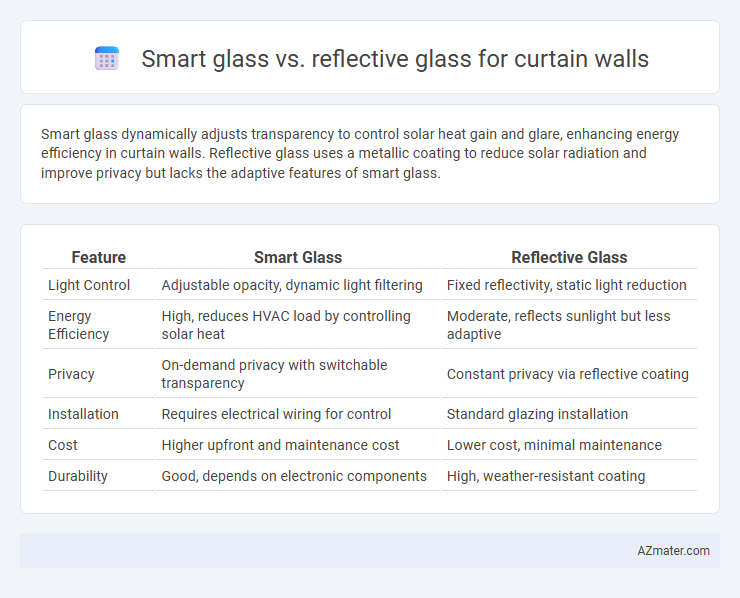Smart glass dynamically adjusts transparency to control solar heat gain and glare, enhancing energy efficiency in curtain walls. Reflective glass uses a metallic coating to reduce solar radiation and improve privacy but lacks the adaptive features of smart glass.
Table of Comparison
| Feature | Smart Glass | Reflective Glass |
|---|---|---|
| Light Control | Adjustable opacity, dynamic light filtering | Fixed reflectivity, static light reduction |
| Energy Efficiency | High, reduces HVAC load by controlling solar heat | Moderate, reflects sunlight but less adaptive |
| Privacy | On-demand privacy with switchable transparency | Constant privacy via reflective coating |
| Installation | Requires electrical wiring for control | Standard glazing installation |
| Cost | Higher upfront and maintenance cost | Lower cost, minimal maintenance |
| Durability | Good, depends on electronic components | High, weather-resistant coating |
Introduction to Curtain Wall Glazing Options
Curtain wall glazing options include smart glass and reflective glass, each offering unique benefits for building facades. Smart glass enhances energy efficiency and occupant comfort by dynamically adjusting transparency and controlling solar heat gain, reducing HVAC costs. Reflective glass improves thermal performance and privacy by reflecting solar radiation, minimizing glare, and contributing to building aesthetics.
What is Smart Glass?
Smart glass, also known as switchable glass, dynamically controls light transmission and heat by altering its properties through electrical, thermal, or light stimuli, enhancing energy efficiency and occupant comfort in curtain wall applications. Compared to reflective glass, which passively reflects sunlight to reduce glare and heat gain, smart glass offers adaptive transparency, allowing for real-time adjustments to solar control and privacy. This technology reduces reliance on blinds or HVAC systems, optimizing daylighting and thermal performance in commercial building facades.
What is Reflective Glass?
Reflective glass is a type of coated glass designed to reduce solar heat gain and glare by reflecting a portion of the incoming sunlight. It features a thin metal or metal oxide coating that enhances energy efficiency in curtain wall systems by minimizing heat transmission while maintaining visibility and natural light. This makes reflective glass a popular choice for commercial buildings aiming to optimize indoor climate control and reduce cooling costs.
Key Differences: Smart Glass vs Reflective Glass
Smart glass modulates light and heat transmission dynamically through electrochromic or thermochromic technology, enhancing energy efficiency and occupant comfort in curtain wall systems. Reflective glass uses a metallic coating to reflect solar radiation, reducing glare and heat gain but offering limited adaptability to changing environmental conditions. Key differences include Smart glass's ability to switch transparency on demand versus reflective glass's static properties, influencing both aesthetic appeal and performance in building facades.
Energy Efficiency Comparison
Smart glass for curtain walls dynamically adjusts its tint to control solar heat gain, significantly enhancing energy efficiency by reducing cooling loads and optimizing natural daylight. Reflective glass provides a constant mirror-like coating that reflects solar radiation, offering effective heat rejection but potentially limiting visible light transmission. Smart glass typically yields greater energy savings and occupant comfort due to its adaptive properties, making it preferable for maximizing energy efficiency in building facades.
Light Control and Privacy Features
Smart glass offers dynamic light control by adjusting transparency electronically, reducing glare and enhancing privacy on demand in curtain wall systems. Reflective glass provides static light reflection, minimizing solar heat gain while maintaining consistent privacy through its mirrored surface. Both options improve energy efficiency, but smart glass delivers adaptable control suited for varying daylight conditions.
Aesthetic and Design Flexibility
Smart glass offers dynamic tinting capabilities, enabling customizable light control and enhanced aesthetic appeal in curtain wall designs. Reflective glass provides a sleek, mirror-like finish that maximizes privacy and adds a bold architectural statement. Smart glass allows greater design flexibility with programmable transparency, while reflective glass delivers consistent visual uniformity and high solar reflectance.
Cost Comparison and Long-Term Value
Smart glass for curtain walls typically has a higher upfront cost than reflective glass due to advanced electrochromic technology and installation complexity. Reflective glass offers lower initial expenses but may incur higher energy costs over time due to less efficient solar heat control. Long-term value favors smart glass by significantly reducing HVAC energy consumption and enhancing occupant comfort, delivering better return on investment despite the initial premium.
Installation and Maintenance Considerations
Smart glass installation requires specialized wiring and control systems integration, increasing initial complexity compared to reflective glass, which typically involves standard glazing procedures compatible with most curtain wall frameworks. Maintenance for smart glass necessitates routine inspection of electronic components and occasional software updates to ensure optimal performance, while reflective glass demands regular cleaning to maintain its reflective properties and prevent surface degradation. Choosing between the two depends on balancing the advanced technological upkeep of smart glass against the simpler, though physically intensive, maintenance regime of reflective glass.
Choosing the Right Glass for Curtain Walls
Selecting the right glass for curtain walls involves evaluating smart glass and reflective glass based on their energy efficiency and aesthetic impact; smart glass offers dynamic tinting to control solar heat gain and glare, enhancing occupant comfort and reducing cooling costs. Reflective glass provides a permanent mirrored surface that improves privacy and reduces solar heat by reflecting a significant portion of sunlight, ideal for harsh sunlight exposure. Consider factors such as climate, building orientation, and desired visual transparency when choosing between these glass types to optimize performance and design.

Infographic: Smart glass vs Reflective glass for Curtain Wall
 azmater.com
azmater.com